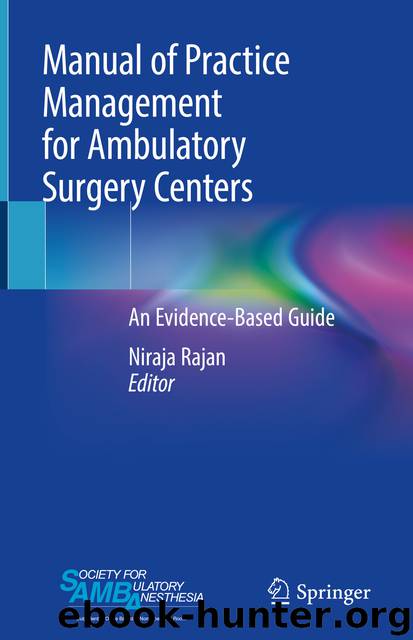Manual of Practice Management for Ambulatory Surgery Centers by Niraja Rajan

Author:Niraja Rajan
Language: eng
Format: epub
ISBN: 9783030191719
Publisher: Springer International Publishing
Short-stay
The risk factors for postoperative outcome can be classified into ‘modifiable’ and ‘non-modifiable’ categories. Non-modifiable factors include age, weight, and presence of sleep-disordered breathing. Although age alone should not be used to determine suitability for ambulatory surgery, most studies have suggested that patients older than 80 years may not be suitable for ambulatory surgery. Obesity is considered a risk factor for perioperative complications after ambulatory surgery; however, weight or body mass index (BMI) should not be the sole determinant of patient selection. Nevertheless, the Society for Ambulatory Anesthesia (SAMBA) recommends that patients with BMI <40 kg/m2 may be suitable for ambulatory surgery assuming that their comorbid conditions, if any, are optimized [18]. The super obese (i.e., BMI >50 kg/m2) should be chosen carefully as they have a higher incidence of perioperative complications. For patients with BMI between 40 and 50 kg/m2, thorough preoperative assessment is necessary to identify obesity-related comorbid conditions (e.g., obstructive sleep apnea [OSA], obesity-related hypoventilation syndrome, and pulmonary hypertension, as well as resistant hypertension, coronary artery disease, and cardiac failure).
The SAMBA consensus statement recommends that patients with a known diagnosis of OSA, who are typically prescribed positive airway pressure [PAP] therapy, may be considered for ambulatory surgery if their comorbid medical conditions are optimized and they are able to use a PAP device in the postoperative period [19, 20]. On the other hand, patients who are unable or unwilling to use a PAP device after discharge can be considered for ambulatory surgery if their comorbid conditions are optimized and if postoperative pain relief can be provided predominantly with non-opioid analgesic techniques, similar to those with a presumed diagnosis of OSA, based on screening tools such as the STOP-Bang questionnaire [19, 20].
In the future, as more patients and surgical procedures are moved from inpatient facilities to outpatient facilities, it will be appropriate to develop exclusion criteria, rather than inclusion criteria, for patients that are not candidates for ambulatory surgery [17].
Download
This site does not store any files on its server. We only index and link to content provided by other sites. Please contact the content providers to delete copyright contents if any and email us, we'll remove relevant links or contents immediately.
| Anesthesiology | Colon & Rectal |
| General Surgery | Laparoscopic & Robotic |
| Neurosurgery | Ophthalmology |
| Oral & Maxillofacial | Orthopedics |
| Otolaryngology | Plastic |
| Thoracic & Vascular | Transplants |
| Trauma |
Periodization Training for Sports by Tudor Bompa(8170)
Why We Sleep: Unlocking the Power of Sleep and Dreams by Matthew Walker(6618)
Paper Towns by Green John(5089)
The Immortal Life of Henrietta Lacks by Rebecca Skloot(4525)
The Sports Rules Book by Human Kinetics(4294)
Dynamic Alignment Through Imagery by Eric Franklin(4118)
ACSM's Complete Guide to Fitness & Health by ACSM(3989)
Kaplan MCAT Organic Chemistry Review: Created for MCAT 2015 (Kaplan Test Prep) by Kaplan(3940)
Introduction to Kinesiology by Shirl J. Hoffman(3726)
Livewired by David Eagleman(3684)
The Death of the Heart by Elizabeth Bowen(3552)
The River of Consciousness by Oliver Sacks(3541)
Alchemy and Alchemists by C. J. S. Thompson(3451)
Bad Pharma by Ben Goldacre(3356)
Descartes' Error by Antonio Damasio(3230)
The Emperor of All Maladies: A Biography of Cancer by Siddhartha Mukherjee(3066)
The Gene: An Intimate History by Siddhartha Mukherjee(3047)
The Fate of Rome: Climate, Disease, and the End of an Empire (The Princeton History of the Ancient World) by Kyle Harper(3003)
Kaplan MCAT Behavioral Sciences Review: Created for MCAT 2015 (Kaplan Test Prep) by Kaplan(2940)
